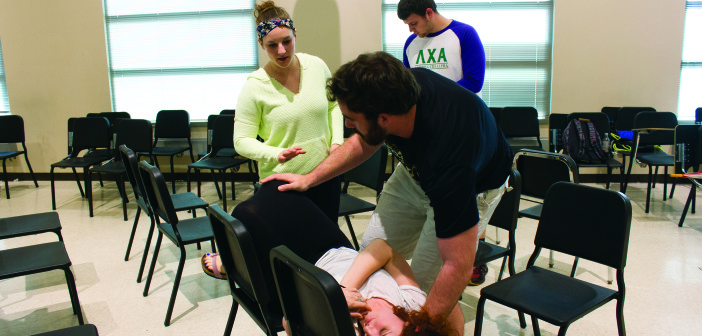Hannah Bevis
Contributing Writer
When the lights go down and the curtain goes up, the audience sees a polished performance that typically runs smoothly from start to finish.
Behind the scenes, however, it’s a whirlwind of activity, as cast members run back and forth between cues, managers make sure everything is in place, and directors try to oversee everything.
“It’s a completely different process,” said Hunter Lindner, stage director of “Erlkonig.” “The lens that you’re looking through is the big thing- you have to focus on the whole rehearsal process and shape as a whole.”
Building a play from the ground up is hardly an easy process and it’s time consuming for everyone involved. After auditions, the first week is usually table work, where all the actors and directors come together to read the script from top to bottom for the first time. Then they start blocking or what senior Cullen Rogers calls “the bare bones and skeleton” of the play itself. They walk through scene-by-scene deciding where actors will stand, how they’ll move, and how the stage will be set up.
After every scene has been blocked, the cast and directors move on to running the script straight through in ‘cleaning rehearsals,’ which is when the directors can get more focused on tweaking the scenes until they’re exactly what they want. Once it gets closer to opening night on Thursday, May 22, they’ll start tech week, which focuses strictly on lighting and designing the stage.
Needless to say, it’s a long process, and one that’s a heavy load for everyone involved.
“It’s almost like a part-time job,” said junior Tina Naponelli, who plays Paige in “Erlkonig.”
All performances are time consuming, but “Erlkonig” had a lot more time put into it than others because it is Roger’s honor thesis project. He’s done research throughout his four years at the College after getting the idea in one of his earlier classes, and the idea developed from there. The script is based on the original poem by Johann Wolfgang van Goethe and Franz Schubert’s musical composition.
“I ended up doing a psych experiment that helped me figure out how to adapt the original song,” explained Rogers. “Then I used that to influence how I wrote the script.”
Writing the script and actually getting the piece from paper to the stage is time consuming enough, but in between the long rehearsals and extensive research, there’s a far more important goal of the actor’s safety. “Erlkonig,” like a few other performances this year, deals with some darker tones and “difficult human issues,” according to Lindner and keeping the cast in a safe space is imperative.
“We have to keep actors safe and comfortable at all times,” said Lindner. “If an actor isn’t comfortable, then they can’t do their job.”
“The priority is always to keep the actors psychologically in a safe space,” said Rogers. “At the same time we try to do scenes tastefully and truthfully and in a way that’s entertaining.”

